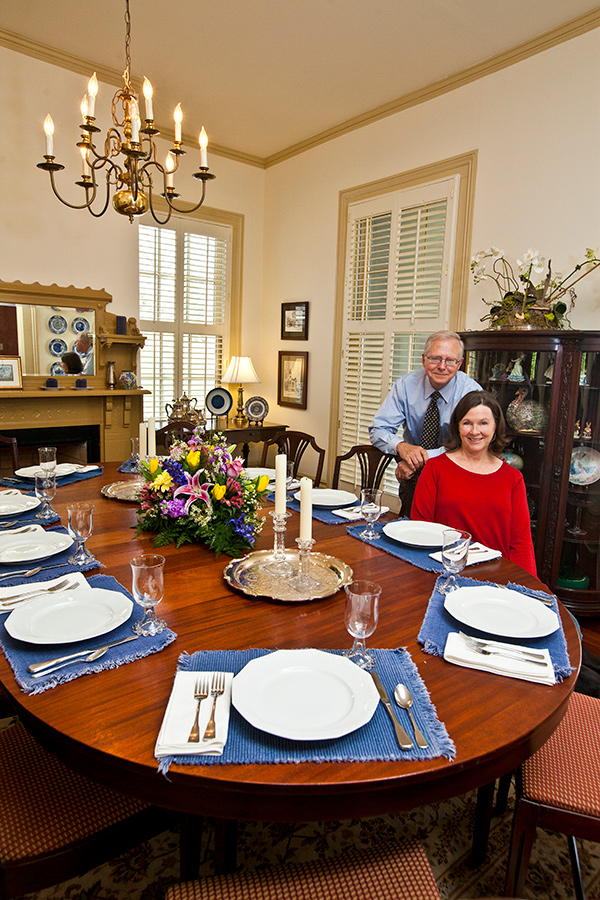Still Standing
How the Oxford College President's House got a new lease on life

Steeped in history: The Bowens can host ten people around the mahogany table in the same dining room where President Few and other early leaders met to plan the future of the little college.
Kay Hinton
It was 2005. Emory’s oldest building, the Old President’s House at Oxford College, had seen better days.
Now its fate was up for grabs. Built in the late 1830s, just a few blocks north of campus, the residence housed four Emory presidents before the campus moved to Atlanta in 1919.
Following the move, the Old President’s House kept its name, but college deans and their families began taking up residence in its modest, yet gracious, space.
Given its age—160 years and counting—it’s not surprising that the house had seen its share of add-ons, renovations, and patchwork. Emory’s first president, Ignatius Few, built the classic “two over two” house (visualize a tall-standing shoe box), with two rooms and a wide foyer downstairs, two rooms upstairs, and the kitchen as a separate building because of the fire risk.
It soon morphed into a plain-style Greek Revival house with two exterior guest rooms (courtesy of President Augustus Longstreet) for visiting circuit-riding ministers and student boarders. The Victorian era left its mark with some dainty gingerbread scrollwork on the front porch. Eventually the house would expand to include five rooms downstairs and four bedrooms upstairs. In one of the rooms that had once sheltered clergy from the elements, students now crowded around a pool table.
Dana Greene 71PhD, a historian and the most recent dean to live in the house, says she “cherished living there because of its history.” But she admitted the house needed help. One of its late-modern additions involved an upstairs master bathroom that was located four steps down from the bedroom. She recalls that you had to be careful navigating those steps first thing in the morning.
So in 2005, the fate of the old house was as shaky as the almost-sanded-through floorboards in the front room. A new dean was arriving, Stephen Bowen—Oxford’s first dean who didn’t graduate from Emory—with his wife, Nancy. Many people agreed that it seemed like the right time to build a modern, energy-efficient home nearby.
The Bowens moved into the house in time for the annual college Christmas party, with faculty and students and a choral group singing in the downstairs foyer. In the front room, Nancy sat next to the Christmas tree, keeping a hand on it to make sure it didn’t topple over as it bobbed and weaved because of the loose floorboards. But she gained an affection for the house: “For us not to live there would leave it sad.”
The right thing to do was restore it. So in summer 2007, Emory began its own version of This Old House. In his book, Cornerstone and Grove: A Portrait in Architecture and Landscape of Emory’s Birthplace in Oxford, Georgia (2009), Erik Oliver 93C 93G details some of the items on the punch list: near-complete reconstruction of the ground-level floors, including floorboards of re-milled and salvaged 1800s heart pine; disposal and replacement of the wooden clapboards saturated with lead paint (a $125,000 bill just to incinerate the wood safely); replacing the old windows with custom-made replicas fitted with insulated glass; completely rebuilding the porches; and landscaping the grounds.

Kay Hinton
Oliver remembers a sense of relief, along with others, that the Bowens decided to restore rather than replace. He grew up in Oxford, the son of Oxford Emeritus Professor of Religion Hoyt Oliver 54OX 56C, and remembers playing in the house with Dean Moncrief’s children—discovering the secret passageways that connected the closets, and stepping off the second-floor balcony right into the magnolia trees that were planted in the 1870s, then removed more than a century later because their roots were damaging the house’s foundation. “It would’ve been a significant departure for him [Dean Bowen] not to live there,” he says.
So where ministers once holed up for the night and students later played pool, Bowen, an accomplished woodworker, makes beautiful wooden bowls from nearby fallen trees. In the other room, Nancy, a certified yoga instructor (and retired Spanish instructor), leads small classes in her studio.
Not only can the Bowens talk the talk about the history of the college, they can walk the walk of the people who lived in the space before them.



